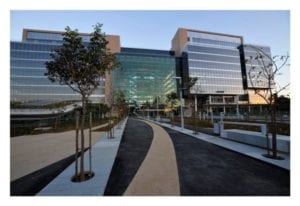The new Standard Bank premises in Rosebank is not only the first project under the green star rating for the Standard Bank team, but also a representation of the banks need to be responsible and think sustainably in the larger global context, according to Karen Ireton, Head of Sustainability Management and Rory Roriston, Head: Property Services at 30 Baker Street, Standard Bank’s new Rosebank building which was opened to the press yesterday, 31 July 2013.
Ireton talked about Standard Bank’s sustainability journey, indicating that for the financial institution a critical area had been the building’s energy profile, given rising energy costs, energy shortages and an increasing global focus on energy efficiency. According to Ireton, business continuity is also key given that the institution operates beyond the traditional 9am to 5pm work cycle. Energy efficiency An existing Egoli Gas main gas line runs past the property. The building therefore makes use of a gas powered tri-generation plant. Tri-generation is the simultaneous production of electrical energy and heat and cooling from a single energy source such as natural gas. Tri-generation is commonly referred to as CCHP (combined cooling, heating, and power generation). Standard Bank Rosebank’s tri-generation plant is South Africa’s second and, at a production capacity of 1MW of energy, it will significantly reduce the building’s carbon footprint.In addition, the rejected heat emitted by the plant will provide 0.8MW of energy that will be used for heating and cooling. Further energy savings will be achieved through efficient lighting. The lighting power density has been reduced to below 2.5W/m² per 100 Lux. A digitally addressable lighting system (DALI) has been installed for 99.26% of the usable area. This allows individual light fittings to be programmed according to need, and facilitates automatic dimming and switching of lighting based on occupancy and daylight availability in the space. Lighting and light power will be individually monitored per floor and energy uses greater than 100kva will be separately metered. A focus on recyclingRoriston further elaborated on the new Rosebank building’s green characteristics and provide insights into its environmental impact. Situated on the corner of Bolton Avenue and Oxford Road, Standard Bank Rosebank has two wings with nine floors in the East Wing and 11 in the West Wing. It will provide occupancy for more than 5 000 employees on a floor space of 74 244m2. It has five parking levels, allowing for 3 915 bays.
According to the team, the offices have been built on previously developed land. Leaking fuel tanks at the petrol station that had occupied one corner of the property had contaminated the soil. During the bulk earthworks, the soil was removed, encapsulated, and disposed of in a hazardous waste site. Rock from the excavations was removed for reuse.Over 60% of the building’s steel has more than 90% post-consumer recycled content, massively reducing the embodied energy. Fifty percent of all the timber has been sourced from Forest Stewardship Council-certified suppliers. A minimum of 20% of the bulky materials permanently installed in the building will be procured from within 400km of the construction site, reducing carbon emissions that would otherwise result from the transportation of materials. The building also uses a minimum of PVC. Additionally, one recycling waste storage area is dedicated to office consumables and a second to kitchen and restaurant waste. Another key facet of the building is that because it has been constructed and designed with sustainability in mind, separation at source has been built in to the flow of the building and will be introduced from first occupation. According to Ireton, only 10 percent of the tenants have taken up occupation, with full occupation only expected for the end of the year (2013). “Then truly we will be able to see the results of our planning.”







